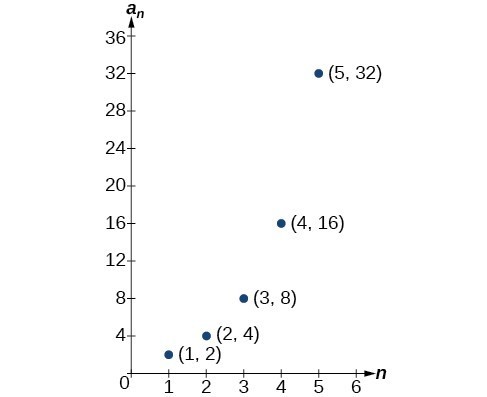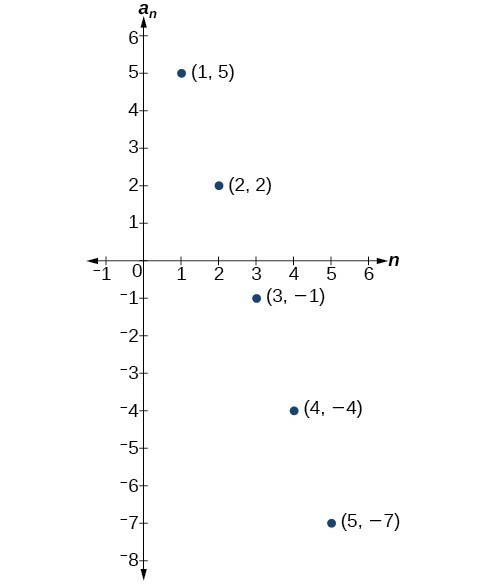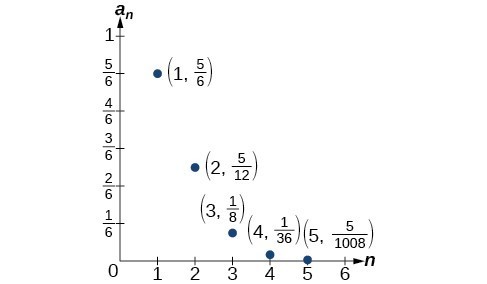Learning Outcomes
- Write the terms of a sequence defined by an explicit formula.
- Write the terms of a sequence defined by a recursive formula.
- Use factorial notation.
A video game company launches an exciting new advertising campaign. They predict the number of online visits to their website, or hits, will double each day. The model they are using shows 2 hits the first day, 4 hits the second day, 8 hits the third day, and so on.
| Day | 1 | 2 | 3 | 4 | 5 | … |
| Hits | 2 | 4 | 8 | 16 | 32 | … |
If their model continues, how many hits will there be at the end of the month? To answer this question, we’ll first need to know how to determine a list of numbers written in a specific order. In this section we will explore these kinds of ordered lists.
Sequences Defined by an Explicit Formula
One way to describe an ordered list of numbers is as a sequence. A sequence is a function whose domain is a subset of the counting numbers. The sequence established by the number of hits on the website is
[latex]\left\{2,4,8,16,32,\dots \right\}[/latex].
The ellipsis (…) indicates that the sequence continues indefinitely. Each number in the sequence is called a term. The first five terms of this sequence are 2, 4, 8, 16, and 32.
Listing all of the terms for a sequence can be cumbersome. For example, finding the number of hits on the website at the end of the month would require listing out as many as 31 terms. A more efficient way to determine a specific term is by writing a formula to define the sequence.
One type of formula is an explicit formula, which defines the terms of a sequence using their position in the sequence. Explicit formulas are helpful if we want to find a specific term of a sequence without finding all of the previous terms. We can use the formula to find the [latex]n\text{th}[/latex] term of the sequence, where [latex]n[/latex] is any positive number. In our example, each number in the sequence is double the previous number, so we can use powers of 2 to write a formula for the [latex]n\text{th}[/latex] term.

The first term of the sequence is [latex]{2}^{1}=2[/latex], the second term is [latex]{2}^{2}=4[/latex], the third term is [latex]{2}^{3}=8[/latex], and so on. The [latex]n\text{th}[/latex] term of the sequence can be found by raising 2 to the [latex]n\text{th}[/latex] power. An explicit formula for a sequence is named by a lower case letter [latex]a,b,c..[/latex]. with the subscript [latex]n[/latex]. The explicit formula for this sequence is
[latex]{a}_{n}={2}^{n}[/latex]
Now that we have a formula for the [latex]n\text{th}[/latex] term of the sequence, we can answer the question posed at the beginning of this section. We were asked to find the number of hits at the end of the month, which we will take to be 31 days. To find the number of hits on the last day of the month, we need to find the 31st term of the sequence. We will substitute 31 for [latex]n[/latex] in the formula.
[latex]\begin{align}{a}_{31}&={2}^{31} \\ &=\text{2,147,483,648} \end{align}[/latex]
If the doubling trend continues, the company will get [latex]\text{2,147,483,648}[/latex] hits on the last day of the month. That is over 2.1 billion hits! The huge number is probably a little unrealistic because it does not take consumer interest and competition into account. It does, however, give the company a starting point from which to consider business decisions.
Another way to represent the sequence is by using a table. The first five terms of the sequence and the [latex]n\text{th}[/latex] term of the sequence are shown in the table.
| [latex]n[/latex] | 1 | 2 | 3 | 4 | 5 | [latex]n[/latex] |
| [latex]n\text{th}[/latex] term of the sequence, [latex]{a}_{n}[/latex] | 2 | 4 | 8 | 16 | 32 | [latex]{2}^{n}[/latex] |
Graphing provides a visual representation of the sequence as a set of distinct points. We can see from the graph below that the number of hits is rising at an exponential rate. This particular sequence forms an exponential function.

Lastly, we can write this particular sequence as
[latex]\left\{2,4,8,16,32,\dots ,{2}^{n},\dots \right\}[/latex].
A sequence that continues indefinitely is called an infinite sequence. The domain of an infinite sequence is the set of counting numbers. If we consider only the first 10 terms of the sequence, we could write
[latex]\left\{2,4,8,16,32,\dots ,1024\right\}[/latex].
This sequence is called a finite sequence because it does not continue indefinitely.
A General Note: Sequence
A sequence is a function whose domain is the set of positive integers. A finite sequence is a sequence whose domain consists of only the first [latex]n[/latex] positive integers. The numbers in a sequence are called terms. The variable [latex]a[/latex] with a number subscript is used to represent the terms in a sequence and to indicate the position of the term in the sequence.
[latex]{a}_{1},{a}_{2},{a}_{3},\dots ,{a}_{n},\dots[/latex]
We call [latex]{a}_{1}[/latex] the first term of the sequence, [latex]{a}_{2}[/latex] the second term of the sequence, [latex]{a}_{3}[/latex] the third term of the sequence, and so on. The term [latex]{a}_{n}[/latex] is called the [latex]n\text{th}[/latex] term of the sequence, or the general term of the sequence. An explicit formula defines the [latex]n\text{th}[/latex] term of a sequence using the position of the term. A sequence that continues indefinitely is an infinite sequence.
Q & A
Does a sequence always have to begin with [latex]{a}_{1}?[/latex]
No. In certain problems, it may be useful to define the initial term as [latex]{a}_{0}[/latex] instead of [latex]{a}_{1}[/latex]. In these problems, the domain of the function includes 0.
How To: Given an explicit formula, write the first [latex]n[/latex] terms of a sequence.
- Substitute each value of [latex]n[/latex] into the formula. Begin with [latex]n=1[/latex] to find the first term, [latex]{a}_{1}[/latex].
- To find the second term, [latex]{a}_{2}[/latex], use [latex]n=2[/latex].
- Continue in the same manner until you have identified all [latex]n[/latex] terms.
Example: Writing the Terms of a Sequence Defined by an Explicit Formula
Write the first five terms of the sequence defined by the explicit formula [latex]{a}_{n}=-3n+8[/latex].
Try It
Write the first five terms of the sequence defined by the explicit formula [latex]{t}_{n}=5n - 4[/latex].
Investigating Explicit Formulas
We’ve learned that sequences are functions whose domain is over the positive integers. This is true for other types of functions, including some piecewise functions. Recall that a piecewise function is a function defined by multiple subsections. A different formula might represent each individual subsection.
How To: Given an explicit formula for a piecewise function, write the first [latex]n[/latex] terms of a sequence
- Identify the formula to which [latex]n=1[/latex] applies.
- To find the first term, [latex]{a}_{1}[/latex], use [latex]n=1[/latex] in the appropriate formula.
- Identify the formula to which [latex]n=2[/latex] applies.
- To find the second term, [latex]{a}_{2}[/latex], use [latex]n=2[/latex] in the appropriate formula.
- Continue in the same manner until you have identified all [latex]n[/latex] terms.
Example: Writing the Terms of a Sequence Defined by a Piecewise Explicit Formula
Write the first six terms of the sequence.
[latex]{a_{n}}=\begin{cases}n^{2} & \text{if }n\text{ is not divisible by 3} \\[1mm] \dfrac{n}{3} & \text{if }n\text{ is divisible by 3}\end{cases}[/latex]
Try It
Write the first six terms of the sequence.
[latex]{a_{n}}=\begin{cases}2n^{3} & \text{if }n\text{ is odd} \\[1mm] \dfrac{5n}{2} & \text{if }n\text{ is even}\end{cases}[/latex]
Finding an Explicit Formula
Thus far, we have been given the explicit formula and asked to find a number of terms of the sequence. Sometimes, the explicit formula for the [latex]n\text{th}[/latex] term of a sequence is not given. Instead, we are given several terms from the sequence. When this happens, we can work in reverse to find an explicit formula from the first few terms of a sequence. The key to finding an explicit formula is to look for a pattern in the terms. Keep in mind that the pattern may involve alternating terms, formulas for numerators, formulas for denominators, exponents, or bases.
How To: Given the first few terms of a sequence, find an explicit formula for the sequence.
- Look for a pattern among the terms.
- If the terms are fractions, look for a separate pattern among the numerators and denominators.
- Look for a pattern among the signs of the terms.
- Write a formula for [latex]{a}_{n}[/latex] in terms of [latex]n[/latex]. Test your formula for [latex]n=1,n=2[/latex], and [latex]n=3[/latex].
Example: Writing an Explicit Formula for the nth Term of a Sequence
Write an explicit formula for the [latex]n\text{th}[/latex] term of each sequence.
- [latex]\left\{-\dfrac{2}{11},\dfrac{3}{13},-\dfrac{4}{15},\dfrac{5}{17},-\dfrac{6}{19},\dots \right\}[/latex]
- [latex]\left\{-\dfrac{2}{25},-\dfrac{2}{125},-\dfrac{2}{625},-\dfrac{2}{3\text{,}125},-\dfrac{2}{15\text{,}625},\dots \right\}[/latex]
- [latex]\left\{{e}^{4},{e}^{5},{e}^{6},{e}^{7},{e}^{8},\dots \right\}[/latex]
Try It
Write an explicit formula for the [latex]n\text{th}[/latex] term of the sequence.
[latex]\{9;−81,729;−6,561;59,049\}[/latex]
Try It
Write an explicit formula for the [latex]n\text{th}[/latex] term of the sequence.
Try It
Write an explicit formula for the [latex]n\text{th}[/latex] term of the sequence.
Investigating Alternating Sequences
Sometimes sequences have terms that alternate in sign. The steps to finding terms of the sequence are the same as if the signs did not alternate. Let’s take a look at the following sequence.
Notice the first term is greater than the second term, the second term is less than the third term, and the third term is greater than the fourth term. This trend continues forever. Do not rearrange the terms in numerical order to interpret the sequence.
How To: Given an explicit formula with alternating terms, write the first [latex]n[/latex] terms of a sequence.
- Substitute each value of [latex]n[/latex] into the formula. Begin with [latex]n=1[/latex] to find the first term, [latex]{a}_{1}[/latex]. The sign of the term in the explicit formula is given by the [latex]{\left(-1\right)}^{n}[/latex] if the first term is negative and [latex]{\left(-1\right)}^{n-1}[/latex] if the first term is positive.
- To find the second term, [latex]{a}_{2}[/latex], use [latex]n=2[/latex].
- Continue in the same manner until you have identified all [latex]n[/latex] terms.
Example: Writing the Terms of an Alternating Sequence Defined by an Explicit Formula
Write the first five terms of the sequence.
Q & A
In Example: Writing the Terms of an Alternating Sequence Defined by an Explicit Formula, does the (–1) to the power of [latex]n[/latex] account for the oscillations of signs?
Yes, the power might be [latex]n,n+1,n - 1[/latex], and so on, but any odd powers will result in a negative term, and any even power will result in a positive term.
Try It
Write the first five terms of the sequence:
Sequences Defined by a Recursive Formula
Sequences occur naturally in the growth patterns of nautilus shells, pinecones, tree branches, and many other natural structures. We may see the sequence in the leaf or branch arrangement, the number of petals of a flower, or the pattern of the chambers in a nautilus shell. Their growth follows the Fibonacci sequence, a famous sequence in which each term can be found by adding the preceding two terms. The numbers in the sequence are 1, 1, 2, 3, 5, 8, 13, 21, 34,…. Other examples from the natural world that exhibit the Fibonacci sequence are the Calla Lily, which has just one petal, the Black-Eyed Susan with 13 petals, and different varieties of daisies that may have 21 or 34 petals.
Each term of the Fibonacci sequence depends on the terms that come before it. The Fibonacci sequence cannot easily be written using an explicit formula. Instead, we describe the sequence using a recursive formula, a formula that defines the terms of a sequence using previous terms.
A recursive formula always has two parts: the value of an initial term (or terms), and an equation defining [latex]{a}_{n}[/latex] in terms of preceding terms. For example, suppose we know the following:
[latex]\begin{align}{a}_{1}&=3 \\ {a}_{n}&=2{a}_{n - 1}-1, \text{for } n\ge 2 \end{align}[/latex]
We can find the subsequent terms of the sequence using the first term.
[latex]\begin{align}{a}_{1}&=3\\ {a}_{2}&=2{a}_{1}-1=2\left(3\right)-1=5\\ {a}_{3}&=2{a}_{2}-1=2\left(5\right)-1=9\\ {a}_{4}&=2{a}_{3}-1=2\left(9\right)-1=17\end{align}[/latex]
So the first four terms of the sequence are [latex]\left\{3,5,9,17\right\}[/latex].
The recursive formula for the Fibonacci sequence states the first two terms and defines each successive term as the sum of the preceding two terms.
[latex]\begin{align}{a}_{1}&=1 \\ {a}_{2}&=1 \\ {a}_{n}&={a}_{n - 1}+{a}_{n - 2}, \text{for } n\ge 3 \end{align}[/latex]
To find the tenth term of the sequence, for example, we would need to add the eighth and ninth terms. We saw above that the eighth and ninth terms are 21 and 34, so
[latex]{a}_{10}={a}_{9}+{a}_{8}=34+21=55[/latex]
A General Note: Recursive Formula
A recursive formula is a formula that defines each term of a sequence using preceding term(s). Recursive formulas must always state the initial term, or terms, of the sequence.
Q & A
Must the first two terms always be given in a recursive formula?
No. The Fibonacci sequence defines each term using the two preceding terms, but many recursive formulas define each term using only one preceding term. These sequences need only the first term to be defined.
How To: Given a recursive formula with only the first term provided, write the first [latex]n[/latex] terms of a sequence.
- Identify the initial term, [latex]{a}_{1}[/latex], which is given as part of the formula. This is the first term.
- To find the second term, [latex]{a}_{2}[/latex], substitute the initial term into the formula for [latex]{a}_{n - 1}[/latex]. Solve.
- To find the third term, [latex]{a}_{3}[/latex], substitute the second term into the formula. Solve.
- Repeat until you have solved for the [latex]n\text{th}[/latex] term.
Example: Writing the Terms of a Sequence Defined by a Recursive Formula
Write the first five terms of the sequence defined by the recursive formula.
[latex]\begin{align} {a}_{1}&=9 \\ {a}_{n}&=3{a}_{n - 1}-20\text{, for }n\ge 2 \end{align}[/latex]
Try It
Write the first five terms of the sequence defined by the recursive formula.
[latex]\begin{align}{a}_{1}&=2\\ {a}_{n}&=2{a}_{n - 1}+1\text{, for }n\ge 2\end{align}[/latex]
Using Factorial Notation
The formulas for some sequences include products of consecutive positive integers. [latex]n[/latex] factorial, written as [latex]n![/latex], is the product of the positive integers from 1 to [latex]n[/latex]. For example,
An example of formula containing a factorial is [latex]{a}_{n}=\left(n+1\right)![/latex]. The sixth term of the sequence can be found by substituting 6 for [latex]n[/latex].
The factorial of any whole number [latex]n[/latex] is [latex]n\left(n - 1\right)![/latex] We can therefore also think of [latex]5![/latex] as [latex]5\cdot 4!\text{.}[/latex]
A GENERAL NOTE: FACTORIAL
n factorial is a mathematical operation that can be defined using a recursive formula. The factorial of [latex]n[/latex], denoted [latex]n![/latex], is defined for a positive integer [latex]n[/latex] as:
The special case [latex]0![/latex] is defined as [latex]0!=1[/latex].
Try It
Q & A
CAN FACTORIALS ALWAYS BE FOUND USING A CALCULATOR?
No. Factorials get large very quickly—faster than even exponential functions! When the output gets too large for the calculator, it will not be able to calculate the factorial.
EXAMPLE: WRITING THE TERMS OF A SEQUENCE USING FACTORIALS
Write the first five terms of the sequence defined by the explicit formula [latex]{a}_{n}=\dfrac{5n}{\left(n+2\right)!}[/latex].
Try It
Write the first five terms of the sequence defined by the explicit formula [latex]{a}_{n}=\dfrac{\left(n+1\right)!}{2n}[/latex].
Key Equations
| Formula for a factorial | [latex]\begin{align}0!&=1\\ 1!&=1\\ n!&=n\left(n - 1\right)\left(n - 2\right)\cdots \left(2\right)\left(1\right)\text{, for }n\ge 2\end{align}[/latex] |
Key Concepts
- A sequence is a list of numbers, called terms, written in a specific order.
- Explicit formulas define each term of a sequence using the position of the term.
- An explicit formula for the [latex]n\text{th}[/latex] term of a sequence can be written by analyzing the pattern of several terms.
- Recursive formulas define each term of a sequence using previous terms.
- Recursive formulas must state the initial term, or terms, of a sequence.
- A set of terms can be written by using a recursive formula.
- A factorial is a mathematical operation that can be defined recursively.
- The factorial of [latex]n[/latex] is the product of all integers from 1 to [latex]n[/latex]
Glossary
explicit formula a formula that defines each term of a sequence in terms of its position in the sequence
finite sequence a function whose domain consists of a finite subset of the positive integers [latex]\left\{1,2,\dots n\right\}[/latex] for some positive integer [latex]n[/latex]
infinite sequence a function whose domain is the set of positive integers
n factorial the product of all the positive integers from 1 to [latex]n[/latex]
nth term of a sequence a formula for the general term of a sequence
recursive formula a formula that defines each term of a sequence using previous term(s)
sequence a function whose domain is a subset of the positive integers
term a number in a sequence
Candela Citations
- Revision and Adaptation. Provided by: Lumen Learning. License: CC BY: Attribution
- College Algebra. Authored by: Abramson, Jay et al.. Provided by: OpenStax. Located at: http://cnx.org/contents/9b08c294-057f-4201-9f48-5d6ad992740d@5.2. License: CC BY: Attribution. License Terms: Download for free at http://cnx.org/contents/9b08c294-057f-4201-9f48-5d6ad992740d@5.2
- Question ID 5846, 5823. Authored by: Webwork-Rochester. License: CC BY: Attribution. License Terms: IMathAS Community License CC-BY + GPL
- Question ID 5805, 5806, 5812. Authored by: David Lippman. License: CC BY: Attribution. License Terms: IMathAS Community License CC-BY + GPL
- Question ID 6107. Authored by: Gregg Harbaugh. License: CC BY: Attribution. License Terms: IMathAS Community License CC-BY + GPL
- Question ID 19458. Authored by: James Sousa. License: CC BY: Attribution. License Terms: IMathAS Community License, CC-BY + GPL
- Question ID 68773. Authored by: Roy Shahbazian. License: CC BY: Attribution. License Terms: IMathAS Community License CC-BY + GPL
- Precalculus. Authored by: OpenStax College. Provided by: OpenStax. Located at: http://cnx.org/contents/fd53eae1-fa23-47c7-bb1b-972349835c3c@5.175:1/Preface. License: CC BY: Attribution



